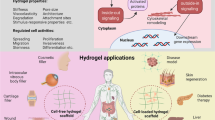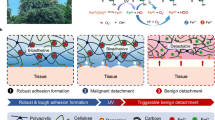Abstract
Novel calcium ion (Ca2+)-responsive hydrogels composed of designed β-sheet peptides were constructed. As the novel designed peptide, E1Y9, has a Glu residue to interact with Ca2+, the peptide in the sol-state self-assembled into hydrogels in the presence of Ca2+. The hydrogelation did not occur in the absence of Ca2+; therefore, Ca2+-dependent hydrogelation was achieved by the molecular design. The hydrogelation from the viscous sol-state solution can be induced by a slower self-assembly process of the β-sheet peptide involving a rapid process of Ca2+binding. When the sol-state peptide solution was injected with Ca2+, gel drops and strings with desired shapes could be constructed. Different cell lines can be cultured on the hydrogel, demonstrating its low toxicity, which is comparable to commercially available microtiter plate surfaces for cell culture. Furthermore, the hydrogels showed a high cell-adhesive ability that was similar in magnitude to fibronectin, which is a native cell-adhesive protein. The Ca2+-responsive peptide nanofiber-based hydrogelation system will facilitate novel studies exploiting self-assembling peptide nanomaterials that will lead to cell-based technology, such as three-dimensional cell culturing.
Similar content being viewed by others
Log in or create a free account to read this content
Gain free access to this article, as well as selected content from this journal and more on nature.com
or
References
Zhang, S. Fabrication of novel biomaterials through molecular self-assembly. Nat. Biotechnol 21, 1171–1179 (2003).
Zhao, X. & Zhang, S. Molecular designer self-assembling peptides. Chem. Soc. Rev. 35, 1105–1110 (2006).
Rajagopal, K. & Schneider, J. Self-assembling peptides and proteins for nanotechnological applications. Curr. Opin. Struct. Biol. 14, 480–486 (2004).
Boyle, A. & Woolfson, D. De novo designed peptides for biological applications. Chem. Soc. Rev. 40, 4295–4601 (2011).
Kodama, H., Matsumura, S., Yamashita, T. & Mihara, H. Construction of a protein array on amyloid-like fibrils using co-assembly of designed peptides. Chem. Commun. 2876–2877 (2004).
Reches, M. & Gazit, E. Casting metal nanowires within discrete self-assembled peptide nanotubes. Science 300, 625–632 (2003).
Paramonov, S., Jun, H. W. & Hartgerink, J. Self-assembly of peptide-amphiphile nanofibers: the roles of hydrogen bonding and amphiphilic packing. J. Am. Chem. Soc. 128, 7291–7299 (2006).
Chang, J., Peng, X.- F., Hijji, K., Cappello, J., Ghandehari, H., Solares, S. & Seog, J. Nanomechanical stimulus accelerates and directs the self-assembly of silk-elastin-like nanofibers. J. Am. Chem. Soc. 133, 1745–1747 (2011).
Lamm, M., Rajagopal, K., Schneider, J. & Pochan, D. Laminated morphology of nontwisting beta-sheet fibrils constructed via peptide self-assembly. J. Am. Chem. Soc. 127, 16692–17000 (2005).
Lamm, M. S., Sharma, N., Rajagopal, K., Beyer, F. L., Schneider, J. P. & Pochan, D. J. Laterally spaced linear nanoparticle arrays templated by laminated beta-sheet fibrils. Adv. Mater. 20, 447–451 (2008).
Matsuura, K., Murasato, K. & Kimizuka, N. Artificial peptide-nanospheres self-assembled from three-way junctions of beta-sheet-forming peptides. J. Am. Chem. Soc. 127, 10148–10157 (2005).
Ghosh, S., Reches, M., Gazit, E. & Verma, S. Bioinspired design of nanocages by self-assembling triskelion peptide elements. Angew. Chem. Int. Ed. 46, 2002–2006 (2007).
Hartgerink, J. D., Beniash, E. & Stupp, S. I. Self-assembly and mineralization of peptide-amphiphile nanofibers. Science 294, 1684–1688 (2001).
Maltzahn, G., Vauthey, S., Santoso, S. & Zhang, S. Positively charged surfactant-like peptides self-assemble into nanostructures. Langmuir 19, 4332–4337 (2003).
Amalia, A., Mark, B., Neville, B., Lisa, M. C. & Andrew, E. S. Self-assembling peptide polyelectrolyte beta-sheet complexes form nematic hydrogels. Anegw. Chem. Int. Ed. 42, 5603–5606 (2003).
Smith, A., Williams, R., Tang, C. & Coppo, P. Fmoc-diphenylalanine self assembles to a hydrogel via a novel architecture based on pi-pi interlocked beta-Sheets. Adv. Mater 20, 37–41 (2008).
Bowerman, C. & Nilsson, B. A reductive trigger for peptide self-assembly and hydrogelation. J. Am. Chem. Soc. 132, 9526–9533 (2010).
Matsumura, S., Uemura, S. & Mihara, H. Fabrication of nanofibers with uniform morphology by self-assembly of designed peptides. Chem. Eur. J 10, 2789–2794 (2004).
Matsumura, S., Uemura, S. & Mihara, H. Construction of biotinylated peptide nanotubes for arranging proteins. Mol. BioSyst. 1, 146–148 (2005).
Sawada, T., Takahashi, T. & Mihara, H. Affinity-based screening of peptides recognizing assembly states of self-assembling peptide nanomaterials. J. Am. Chem. Soc. 131, 14434–14475 (2009).
Miyachi, A., Takahashi, T., Matsumura, S. & Mihara, H. Peptide nanofibers modified with a protein by using designed anchor molecules bearing hydrophobic and functional moieties. Chem. Eur. J 16, 6644–6694 (2010).
Sawada, T. & Mihara, H. Dense surface functionalization using peptides that recognize differences in organized structures of self-assembling nanomaterials. Mol. BioSyst. 8, 1264–1274 (2012).
Mart, R., Osborne, R. & Stevens, M. Peptide-based stimuli-responsive biomaterials. Soft Matter 2, 822–835 (2006).
White, P. D. & Chan, W. C. in Fmoc Solid Phase Peptide Synthesis: A Practical Approach eds P. D. White, W. C. Chan 41–76 Oxford University Press, (2000).
Haris, P. & Chapman, D. The conformational analysis of peptides using Fourier transform IR spectroscopy. Biopolymers 37, 251–263 (1995).
Srisailam, S., Kumar, T., Rajalingam, D., Kathir, K., Sheu, H.- S, Jan, F.- J, Chao, P.- C. & Yu, C. Amyloid-like fibril formation in an all beta-barrel protein. Partially structured intermediate state(s) is a precursor for fibril formation. J. Biol. Chem 278, 17701–17710 (2003).
Moses, J. P., Satheeshkumar, K., Murali, J., Alli, D. & Jayakumar, R. Self-assembly of the synthetic polymer (Leu-Glu)n: an amyloid-like structure formation. Langmuir 19, 3413–3418 (2003).
Holmes, T., de Lacalle, S., Su, X., Liu, G., Rich, A. & Zhang, S. Extensive neurite outgrowth and active synapse formation on self-assembling peptide scaffolds. Proc. Natl. Acad. Sci. USA. 97, 6728–6761 (2000).
Kretsinger, J., Haines, L., Ozbas, B., Pochan, D. & Schneider, J. Cytocompatibility of self-assembled beta-hairpin peptide hydrogel surfaces. Biomaterials 26, 5177–5263 (2005).
Acknowledgements
We thank Prof E Kobatake and Dr M Mie (Tokyo Institute of Technology) for help with the cell experiments and for insightful discussions. This work is supported by a Grant-in-Aid for Scientific Research on Innovative Areas of ‘Fusion Materials’(no. 2206) from the Ministry of Education, Culture, Sports, Science and Technology, Japan. TS is grateful to the Japan Society for the Promotion of Science (JSPS) for a Research Fellowship for Young Scientists.
Author information
Authors and Affiliations
Corresponding author
Additional information
Supplementary Information accompanies the paper on Polymer Journal website
Supplementary information
Rights and permissions
About this article
Cite this article
Sawada, T., Tsuchiya, M., Takahashi, T. et al. Cell-adhesive hydrogels composed of peptide nanofibers responsive to biological ions. Polym J 44, 651–657 (2012). https://doi.org/10.1038/pj.2012.48
Received:
Revised:
Accepted:
Published:
Issue date:
DOI: https://doi.org/10.1038/pj.2012.48
Keywords
This article is cited by
-
Intracellular artificial supramolecules based on de novo designed Y15 peptides
Nature Communications (2021)
-
Functionalization of self-assembling peptide materials using molecular recognition of supramolecular peptide nanofibers
Polymer Journal (2020)
-
Stimuli-responsive supramolecular systems guided by chemical reactions
Polymer Journal (2019)
-
Cellular behaviors on polymeric scaffolds with 2D-patterned mechanical properties
Polymer Journal (2018)
-
Filamentous virus-based soft materials based on controlled assembly through liquid crystalline formation
Polymer Journal (2017)



